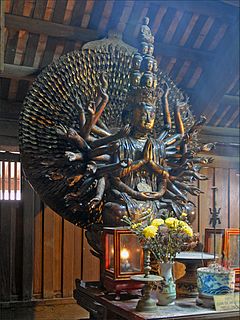External links
- Buddhistforbundet's web site (Norwegian only)
The Buddhist Federation of Norway (Norwegian: Buddhistforbundet) is an umbrella organization for the different Buddhist groups in Norway. It was founded in 1979 by two Buddhist groups (Rinzai Zen Senter and Karma Tashi Ling buddhistsamfunn) with the aim of creating an organization to deal with issues of common interest for all Norwegian Buddhists, and which could represent all the separate groups to the government. The main goal of Buddhistforbundet today is to foster communication and good relations between Buddhists of all traditions and groups, in order to promote Buddhist principles and practice in Norway.
Buddhism in the West broadly encompasses the knowledge and practice of Buddhism outside of Asia in the Western world. Occasional intersections between Western civilization and the Buddhist world have been occurring for thousands of years. The first Westerners to become Buddhists were Greeks who settled in Bactria and India during the Hellenistic period. They became influential figures during the reigns of the Indo-Greek kings, whose patronage of Buddhism led to the emergence of Greco-Buddhism and Greco-Buddhist art. There was little contact between the Western and Buddhist cultures during most of the Middle Ages but the early modern rise of global trade and mercantilism, improved navigation technology and the European colonization of Asian Buddhist countries led to increased knowledge of Buddhism among Westerners. This increased contact led to various responses from Buddhists and Westerners throughout the modern era. These include religious proselytism, religious polemics and debates, Buddhist modernism, Western convert Buddhists and the rise of Buddhist studies in Western academia. During the 20th century, there was a growth in Western Buddhism due to various factors such as immigration, globalization, the decline of Christianity and increased interest among Westerners. The various schools of Buddhism are now established in all major Western countries making up a small minority in the United States, Europe, Australia and New Zealand.
The English term enlightenment is the western translation of the abstract noun bodhi,, the knowledge or wisdom, or awakened intellect, of a Buddha. The verbal root budh- means "to awaken," and its literal meaning is closer to awakening. Although the term buddhi is also used in other Indian philosophies and traditions, its most common usage is in the context of Buddhism. The term "enlightenment" was popularised in the Western world through the 19th century translations of Max Müller. It has the western connotation of general insight into transcendental truth or reality.
The World Fellowship of Buddhists (WFB) is an international Buddhist organization. Initiated by Gunapala Piyasena Malalasekera, it was founded in 1950 in Colombo, Ceylon, by representatives from 27 nations. Although Theravada Buddhists are most influential in the organization,, members of all Buddhist schools are active in the WFB. It now has regional centers in 35 countries, including India, the United States, Australia, and several nations of Africa and Europe, in addition to traditional Buddhist countries.

The schools of Buddhism are the various institutional and doctrinal divisions of Buddhism that have existed from ancient times up to the present. The classification and nature of various doctrinal, philosophical or cultural facets of the schools of Buddhism is vague and has been interpreted in many different ways, often due to the sheer number of different sects, subsects, movements, etc. that have made up or currently make up the whole of Buddhist traditions. The sectarian and conceptual divisions of Buddhist thought are part of the modern framework of Buddhist studies, as well as comparative religion in Asia.
Buddhism is a legally recognized religion in Austria. Although still small in absolute numbers, Buddhism in Austria enjoys widespread acceptance. A majority of Buddhists in the country are Austrian nationals, while a considerable number of them are foreign nationals.

Buddhism, once primarily practiced in Asia, is now also practiced in the United States. As Buddhism does not require any formal "conversion", American Buddhists can easily incorporate dharma practice into their normal routines and traditions. The result is that American Buddhists come from every ethnicity, nationality and religious tradition. In 2012, U-T San Diego estimated U.S. practitioners at 1.2 million people, of whom 40% are living in Southern California. In terms of percentage, Hawaii has the most Buddhists at 8% of the population, due to its large Asian American community.

Buddhism in Vietnam, as practised by the ethnic Vietnamese, is mainly of the Mahayana tradition and is the main religion. Buddhism may have first come to Vietnam as early as the 3rd or 2nd century BCE from the Indian subcontinent or from China in the 1st or 2nd century CE. Vietnamese Buddhism has had a syncretic relationship with certain elements of Taoism, Chinese spirituality, and Vietnamese folk religion.
The European Buddhist Union (EBU) is the umbrella organization of Buddhist communities and national Buddhist unions in Europe. The EBU is open to all schools and traditions of Buddhism in Europe wishing to unite on the basis of Buddhist teachings and work together in spiritual friendship and respect for diversity. According to the 'EBU Statement of Mission and Vision' the aims are to facilitate international exchange and promote spiritual friendship amongst European Buddhists, to support social action and ideas motivated by Buddhist values, and to amplify the voice of Buddhism in Europe and worldwide.

Buddhism in Norway has existed since the beginning of the 1970s, after immigration from countries with Buddhist populations, mainly Vietnam. Buddhistforbundet in Norway was established as a religious society in 1979 by two Buddhist groups who wanted to create a common organization to preserve issues of common interest. As of 2013, there are over 30 to 50 thousand registered Buddhists in Norway. Around 5% of them are ethnic Norwegians.

Buddhism is the fourth largest religion in France, after Christianity, Islam, and Judaism.

Although there was regular contact between practising Buddhists and Europeans in antiquity the former had little direct impact. In the latter half of the 19th century, Buddhism came to the attention of Western intellectuals and during the course of the following century the number of adherents has grown. There are now between 1 and 4 million Buddhists in Europe, the majority in Germany, Italy, France and the United Kingdom.

Japanese Zen refers to the Japanese forms of Zen Buddhism, an originally Chinese Mahāyāna school of Buddhism that strongly emphasizes dhyāna, the meditative training of awareness and equanimity. This practice, according to Zen proponents, gives insight into one's true nature, or the emptiness of inherent existence, which opens the way to a liberated way of living.
Buddhism in Ukraine has existed since the 19th and 20th century, after immigration from countries with Buddhist populations, mainly North Vietnam and Korea under Communist period. Although sources are not readily available, Buddhists are believed to constitute 0.1% of the total population in Ukraine.
Buddhism in the United Kingdom has a small but growing number of adherents which, according to a Buddhist organisation, is mainly a result of conversion. In the UK census for 2011, there were about 178,000 people who registered their religion as Buddhism, and about 174,000 who cited religions other than Christianity, Buddhism, Hinduism, Judaism, Islam, Jainism and Sikhism. This latter figure is likely to include some people who follow the traditional Chinese folk religion which also includes some elements of Buddhism.

Buddhism in Scotland is a relatively recent phenomenon. In Scotland Buddhists represent 12% of the population or 12,79975 people.
Buddhism in Wales has a relatively short history, having only really established a presence in the country in the 20th Century. 9,117 people in Wales declared themselves Buddhist in the 2011 Census, representing a number of Buddhist traditions. Tibetan Buddhism is particularly well represented with branches of several different traditions and lineages, notably Lama Shenpen Hookham's Awakened Heart Sangha, based in North Wales. Zen Buddhism has several groups in Wales and three Soto Zen masters are currently resident and actively teaching. The Samatha Trust, a lay Theravada group, have their headquarters in Wales as does the Tibetan group, Awakened Heart Sangha. The Triratna Buddhist Community have a number of groups and a large Cardiff Buddhist Centre. The Nyingma Aro gTér Lineage has been active in Wales since 1981. The Aro gTér Lineage Holders, Ngak’chang Rinpoche and Khandro Déchen, are resident in Wales and have written many publications about Vajrayana Buddhist practice. Another Welsh author of this lineage is Ngakma Nor’dzin Pamo who is a teacher at Aro Ling Cardiff.
Buddhist modernism are new movements based on modern era reinterpretations of Buddhism. David McMahan states that modernism in Buddhism is similar to those found in other religions. The sources of influences have variously been an engagement of Buddhist communities and teachers with the new cultures and methodologies such as "western monotheism; rationalism and scientific naturalism; and Romantic expressivism". The influence of monotheism has been the internalization of Buddhist gods to make it acceptable in modern West, while scientific naturalism and romanticism has influenced the emphasis on current life, empirical defense, reason, psychological and health benefits.

The Third Bardor Tulku Rinpoche' is a Tibetan Buddhist teacher, a holder of the religious lineage of Terchen Barway Dorje. Rinpoche is the founder of a Tibetan Buddhist center, Kunzang Palchen Ling, and the Raktrul Foundation, in Red Hook, New York.

Zen is a school of Mahayana Buddhism that originated in China during the Tang dynasty, known as the Chan School, and later developed into various schools. The Chan School was strongly influenced by Taoist philosophy, especially Neo-Daoist thought, and developed as a distinct school of Chinese Buddhism. From China, Chán spread south to Vietnam and became Vietnamese Thiền, northeast to Korea to become Seon Buddhism, and east to Japan, becoming Japanese Zen.

Thiền Buddhism is the Vietnamese version of Zen Buddhism. Thiền is the Sino-Vietnamese pronunciation of the Middle Chinese word 禪 (chán), an abbreviation of 禪那 (chánnà), which is a transliteration of the Sanskrit word dhyāna ("meditation").